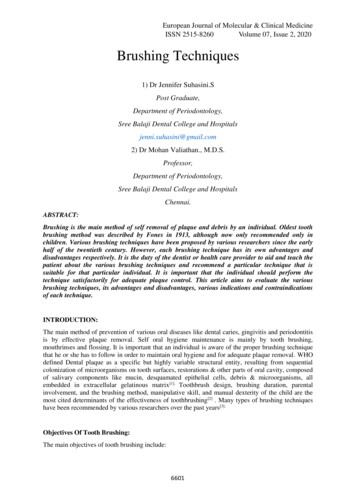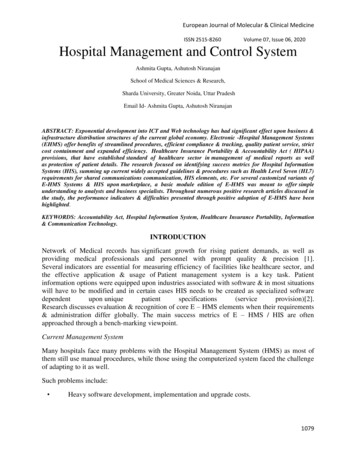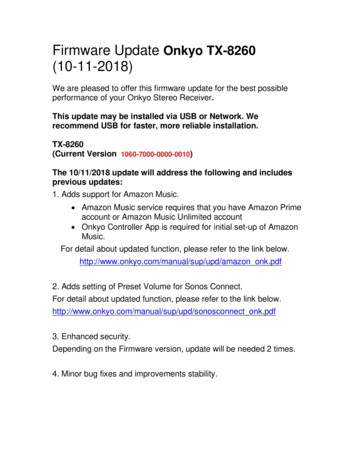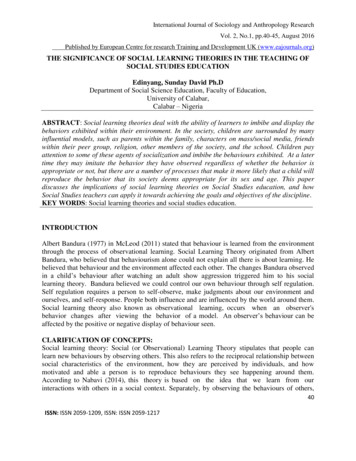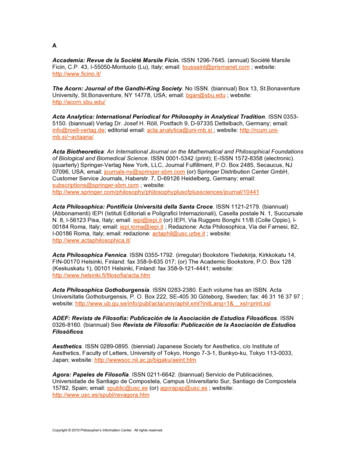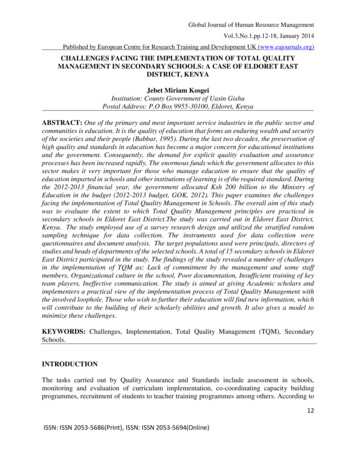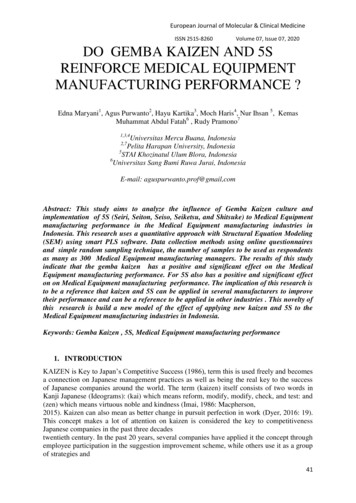
Transcription
European Journal of Molecular & Clinical MedicineISSN 2515-8260Volume 07, Issue 07, 2020DO GEMBA KAIZEN AND 5SREINFORCE MEDICAL EQUIPMENTMANUFACTURING PERFORMANCE ?Edna Maryani1, Agus Purwanto2, Hayu Kartika3, Moch Haris4, Nur Ihsan 5, KemasMuhammat Abdul Fatah6 , Rudy Pramono71,3,4Universitas Mercu Buana, IndonesiaPelita Harapan University, Indonesia5STAI Khozinatul Ulum Blora, Indonesia6Universitas Sang Bumi Ruwa Jurai, Indonesia2,7E-mail: aguspurwanto.prof@gmail,comAbstract: This study aims to analyze the influence of Gemba Kaizen culture andimplementation of 5S (Seiri, Seiton, Seiso, Seiketsu, and Shitsuke) to Medical Equipmentmanufacturing performance in the Medical Equipment manufacturing industries inIndonesia. This research uses a quantitative approach with Structural Equation Modeling(SEM) using smart PLS software. Data collection methods using online questionnairesand simple random sampling technique, the number of samples to be used as respondentsas many as 300 Medical Equipment manufacturing managers. The results of this studyindicate that the gemba kaizen has a positive and significant effect on the MedicalEquipment manufacturing performance. For 5S also has a positive and significant effecton on Medical Equipment manufacturing performance. The implication of this research isto be a reference that kaizen and 5S can be applied in several manufacturers to improvetheir performance and can be a reference to be applied in other industries . This novelty ofthis research is build a new model of the effect of applying new kaizen and 5S to theMedical Equipment manufacturing industries in Indonesia.Keywords: Gemba Kaizen , 5S, Medical Equipment manufacturing performance1. INTRODUCTIONKAIZEN is Key to Japan’s Competitive Success (1986), term this is used freely and becomesa connection on Japanese management practices as well as being the real key to the successof Japanese companies around the world. The term (kaizen) itself consists of two words inKanji Japanese (Ideograms): (kai) which means reform, modify, modify, check, and test: and(zen) which means virtuous noble and kindness (Imai, 1986: Macpherson,2015). Kaizen can also mean as better change in pursuit perfection in work (Dyer, 2016: 19).This concept makes a lot of attention on kaizen is considered the key to competitivenessJapanese companies in the past three decadestwentieth century. In the past 20 years, several companies have applied it the concept throughemployee participation in the suggestion improvement scheme, while others use it as a groupof strategies and41
European Journal of Molecular & Clinical MedicineISSN 2515-8260Volume 07, Issue 07, 2020a tool to reduce waste (Imai, 1986: Suarez-Barraza et al, 2011). Japanese companies began toimplement kaizen at the end of the 20th century. Since then, some western companies likeCatterpillar (Illinois, USA), Harley Davidson (Wisconsin, USA), Husqvarna (Jönköping,Sweden) and GDM Group & Q-West (Wanganui, New Zealand), use kaizen to improvetechniques production, systematic operation, and searching more contributions fromemployees (Macpherson, 2015: 3). The kaizen strategy mainly depends on human endeavorsto improve yields, and things it requires process improvement. Process-oriented approachreferred to as the "plan-do-check-act" cycle(PDCA) and SDCA "standardize-do-check-act" to improve the improvement process. Cyclethis can be called an increase cycle (Imai, 1986: Smadi, 2009). Introduction to concepts mainkaizen, as well as the main kaizen system can applied in implementing culture kaizen to thecompany. That's why understanding about the main concepts and systems of kaizen isessential for the company. The purpose of kaizen is to improve three parameters: quality,cost, and submission or can be called QCD (quality, cost, delivery) (Karas et al., 2016: Imai,1997). This matter means that kaizen focuses on improvement quality of goods or services, aswell as striving to reduce costs at each stage business organizations in order to shorten timework. The goals of the kaizen culture reflect that continuous improvement must have the finalgoal in its application. In essence, it can be concluded from general explanation above is thatthe culture of kaizen is a better change (Macpherson, 2015: 3). That's why kaizen gets used invarious fields and industrial lines for companies that apply it. Because the main focus ofkaizen is the contribution each individual in the company makes continuous change, kaizentoo regulate and improve the quality of individuals in in the company. Management ofresource management humans in this way kaizen form new discipline in change for thebetter. The main assumption of kaizen is to encourage employees so they can continue toimprove the place work / workplace (Shepherd). That matter contribute to independence andself control the big that can be achieved by employees. Duty the main employee in a gemba isto maintain and improve or enhance standards in achieving quality, cost, and submission(QCD) which is accommodating (Imai,1997).Lean Medical Equipment manufacturing is a production technique that considers theexpenditure of resources in the production process. The technique aims to reduce the wastethat can be generated during the production process. According to Kilpatrick (2003), onemethod for implementing lean Medical Equipment manufacturing in companies is the 5Smethod. 5S method is a work method from Japan that applies work environment managementand arrangement. This arrangement aims to create a neat and comfortable work environmentso that work effectiveness can be increased. Kumar and Kumar (2012) state thatimplementing 5S can reduce the number of defective products and maximize the use of spacein the work environment. The application of 5S method also instills discipline in workers sothat workers have the desire to maintain the tidiness of the work environment. 5S methodconsists of five methods, namely seiri, seiton, seiso, seiketsu, and shitsuke. Seiri (concise)means that a good work environment is free from excess tools and materials that are not used.Seiton (neat) means that a good layout arrangement for the tools and materials needed in theproduction process can increase worker effectiveness. Seiso (rehearsal) means that acomfortable work environment can be achieved by maintaining cleanliness. Seiketsu (care)means that a comfortable work environment must be maintained so that the workingenvironment conditions remain comfortable and optimal. Shitsuke (diligent) means that theapplication of seiri, seiton, and seiso in a company will survive if workers are accustomed toapplying it to their daily work. In practice, the first three S values (Seiri, Seiton, and Seiso)are values that are applied on an individual scale, while the last two S values (Seiketsu and42
European Journal of Molecular & Clinical MedicineISSN 2515-8260Volume 07, Issue 07, 2020Shitsuke) are values that are applied on a managerial scale. Seiketsu and Shitsuke are neededto maintain and improve the application of Seiri, Seiton and Seiso (Pasale, 2013).The 5S program (Seiri, Seiton, Seiso, Seiketsu and Shitsuke) is the basis for an employeementality to make improvements and also to realize quality awareness (Heizer and Render,2009). 5S is an approach in managing the work environment, which in essence seeks toeliminate waste so as to create an effective, efficient and productive work environment(Osada, 2004). While Hirano (1996) defines 5S as a tool to help express problems and if usedappropriately can become a part of the process from a well-planned lean system. 5S itself isan abbreviation of Seiri (Sort), Seiton (Straighten), Seiso (Shine), Seiketsu (Standardize), andShitsuke (Sustain). In Indonesian it is translated as 5R which means Concise, Neat, Clean,Rawat, Diligent. According to Imai (2001) 5S is very important because it is the foundationin making a process as short as possible, reducing production costs, quality output andreducing the incidence of accidents in the presence of better conditions. Seiri (Sort) orConcise, is the stage of distinguishing items that are needed and not needed, take firmdecisions and implement stratification management to dispose of unnecessary and store itemsthat are still needed (Osada, 2004). The item differentiation is intended to make the worksystem become concise. Efforts are made to get rid of goods that are no longer useful, so thecompany will have a wider workspace. Seiton (Straighten) or Neat, is the stage of storinggoods in the right place or in the right layout by emphasizing the aspects of safety, qualityand effectiveness, so that it can be used in a sudden situation (Hirano, 1998). This is useful toeliminate time wasted in the process of finding goods and workplaces to be more presentable.Seiso (Shine) or Resik is the third stage in the 5S method. The principle of Seiso or shine is toclean the work place or environment, machinery or equipment and other items so that there isno dust or dirt and rubbish littered. Clean conditions can affect humans psychologically bymaking themselves feel comfortable and not feeling stressed (Hirano, 1998). The initial stepsthat can be done at this stage such as throwing trash in place and cleaning the floor in theworkspace. Seiketsu (Standardize) or Rawat is an activity where everyone must try tomaintain the progress that has been achieved through the Seiri, Seiton and Seiso stagesbefore. At this stage the results achieved have been maintained by standardizing orstandardizing (Imai, 2001). The last step in the 5S method is Shitsuke (Sustain) or Diligent.The principle of Shitsuke is the creation of personal habits of employees to maintain andimprove what has been achieved. Discipline in the workplace is the development of positivehabits in the workplace (Heizer and Render, 2009).Falkowski and Kitowski (2013) state that the application of Seiri is to remove tools and itemsthat are not used in the operation process. Bhoi et al. (2014) states that tools and itemsreleased through the implementation of Seiri will be accommodated in the quarantine area.Reducing tools and materials that are not used can increase the area of work and increase theeffectiveness of the movement of workers. Kaluarachchi (2009) states that Castle StreetHospital for Women (CSHW) in Sri Lanka implements seiri by sorting medical devices basedon their conditions and making a place for collection and repair of medical devices that donot meet government standards. Zidel (2006) states that the application of seiton means thateach tool and material in the work environment has its own place. Michalska and Szewieczek(2007) state that the storage of tools and materials should be labeled (name tags) to makethem easier to find. Storage of tools and materials will be adjusted to the operator's range, sothat the operator's movements become more effective. Ramesh et al. (2014) states that thepreparation of tools and materials is based on the level of use of tools and materials duringthe production process. Kaluarachchi (2009) states that CSHW in Sri Lanka applies seitonsby rearranging sterile fabric storage areas, and also provides direction markers for areas in43
European Journal of Molecular & Clinical MedicineISSN 2515-8260Volume 07, Issue 07, 2020hospitals. Pasale and Bagi (2013b) state that the application of SEISO also includes checkingengine cleanliness, light sources, and air ducts. The hygiene facilities needed for theapplication of seiso include bins, brooms, dust cleaners, and floor mats. Korkut et al. (2008)stated that cleaning the work environment should be done at the beginning of a work shift,the end of a work shift, or after a break. Veža et al (2011) states that an example of applyingseiso in the work environment is to use transparent plastic bags as trash bins. The use oftransparent plastic bags is considered easier for handling garbage and other impuritiescompared to using plastic or cardboard boxes. Kaluarachchi (2009) stated that CSHW in SriLanka implemented a procedure to maintain the cleanliness of floors and toilets in hospitals.Gürel (2013) states that seiri, seiton and seiso must have standards through the application ofseiketsu to maintain the continuity of the 5S program. According to Lingareddy et al. (2013),the application of Seiketsu means that everyone must know their respective responsibilities inimplementing 5S. One of the things that can be done is to make cleaning the workenvironment one of the daily work routines. Mallick et al. (2013) states that visualmanagement such as the 5S picket schedule can be used as an effort to implement seiketsu.The purpose of this study is to determine the influence of gemba kaizen and 5S culture onMedical Equipment manufacturing performance. The benefit of this research is to provide ananalysis and explanation of the influence of gemba kaizen and 5S culture on MedicalEquipment manufacturing performance. Based on the theoretical review and the results of theempirical findings above, the hypotheses are submitted in this study are:H1 (hypotheses 1) : It is suspected that gemba kaizen has a positive and significant effect onMedical Equipment manufacturing performance.H2 (hypotheses 2) : It is suspected that 5S has a positive and significant effect on MedicalEquipment manufacturing performance.2. LITERATURE REVIEW AND HYPOTHESIS DEVELOPMENTRelationship Gemba Kaizen and Medical Equipment manufacturing PerformanceAccording to Chiarini (2018) many theoretical parallelisms as well as lessons forpractitioners, in particular referring to principles such as Jidoka, just-in-time, wasteidentification and elimination, challenge, Kaizen, Genchi Genbutsu, respect for people andteamwork. According to Kumar et al.(2014) Kaizen reduced processing time has beenreduced by 44.4 percent and an amount of Rs. 64,000 has been saved by recovering a total of80 square feet working area. Improvements in the form of work flow have been achieved. Voet al.(2019) study utilizes a Kaizen event’s case study data with the help of various wastedetection and elimination tools and techniques. Changes in overall productivity along withpotential long-term improvements in the delivery process are also analyzed and documented.According to Kumar et al.(2014) Pre- and post-quality measures are provided todemonstrate the results of the event on the production quality and on the performance of theoverall Medical Equipment manufacturing processes. According to Chan et al (2018)application of a mix of lean tools resulted in significant productivity improvements of 10-30percent in the assembly area of the printing company. Based on the outcomes of the leantools that are applied in various work areas, the best combinations of lean tools are identifiedand several key considerations are discussed. Al Smadi (2009) if properly implemented,Kaizen model can substantially contribute to continuous improvement and, thus, driveorganizations for high competitiveness without a need for major investment. Woong et al(2014) similarities between Quality Circles and Kaizen Events were identified in everycomponent of the logic model. Both mechanisms were effective in driving improvements in44
European Journal of Molecular & Clinical MedicineISSN 2515-8260Volume 07, Issue 07, 2020performance and in motivating employees, even though significant differences in the projectsize, type, and industrial sector existed across the six different projects. Mitra (2019) It wasfound that the yield was increased from 88.3 to 92.2 percent, which was a significant change,as far as the product line is concerned. The product complaints were reduced to zero with anadded increased product quality rating system to 98.2 from the existing rating of 96.7. Theproduct consistency was also improved as an application of Lean in the Medical Equipmentmanufacturing process. Arya et al (2015) the benefit of kaizen is inventory access time isreduced up to 87 per cent and total distance travelled and total time taken by product isreduced up to 43.75 and 46.08 per cent, respectively. A habit to maintain a clean workplacehas been developed in workersHypothesis 1 : Gemba Kaizen has a positive and significant relationship with MedicalEquipment manufacturing performanceRelationship 5S and Medical Equipment manufacturing PerformanceRandhwa (2017) 5S is an outstanding Japanese philosophy for the development of any typeorganization all over the world. This study bring out the concept of 5S, requirements for itsholistic implementation, relationship with other lean tools, benefits, success factors andobstacles in 5S implementation. Randhwa (2017) The significant contributions through 5Sinitiatives in the organization like production, quality, safety and effective utilization ofworkspace for the sustained organizational improvement have also been highlighted in thestudy. Enshassi et al (2019) 5S techniques applied to reduce the causes of accidents that wereapplicable were cleaning the workplace and removing materials and machines that are notrequired; conducting accident investigation and root cause analysis programmes; and usingsafety signs and labels on site. Suarez (2012) based on cross analysis findings, a group ofreasons was found for applying the 5Ss in the multinational organisations analysed, alongwith a group of drivers and inhibitors responsible for enhancing or blocking the successfulimplementation of the 5Ss. Suarez (2012) a conceptual framework was also established,based on the results of comparing theory and fieldwork: this provides a glimpse into therelationship of the 5Ss with other improvement programmes, known as Lean‐thinking orLean‐Kaizen, in the organisations analysed. In particular, the framework show the importancebetween do (way: philosophy) and jyutsu (techniques) during the implantation process of5Ss. Cheng (2018) study identified the following factors in effective and efficientdissemination of 5S-KAIZEN-TQM activities in the Egyptian health sector: restructuring thequality management structure to establish Quality Improvement Teams and WorkImprovement Teams in hospitals, generating strong leadership and commitment amongleaders, conducting effective in-house trainings on the 5S-KAIZEN-TQM approach,monitoring and following up on 5S-KAIZEN-TQM activities and introducing the 5SKAIZEN-TQM approach using non-clinical sections, which could also influence thesustainability of the activities.Hypothesis 2 : 5S has a positive and significant relationship with Medical Equipmentmanufacturing performance3. METHODThe type of this research approach is quantitative research. In this study the type of data usedis quantitative data. The sampling technique used in this research method is simple randomsampling. The number of respondents used in this study were 300 Medical Equipment45
European Journal of Molecular & Clinical MedicineISSN 2515-8260Volume 07, Issue 07, 2020manufacturing company managers in Indonesia. The method used to retrieve data fromrespondents is to use a questionnaire. For Gemba kaizen variables according to Risma (2008)measured by continuous improvement and improvement while the 5S indicator is 5 indicatorsnamely seiri (concise), seiton (neat), seiso (rehearsal), seiketsu (caring), and shitsuke(diligent). Medical Equipment manufacturing performance variables according toMangkunegara (2009) are measured by 4 indicators namely quality, quantity, performance oftasks, and responsibilities.The questionnaire was designed closed except for questions orstatements about the identity of respondents in the form of a semi-open questionnaire. Eachclosed question or statement item is given five answer options i.e. strongly agree (SS) score5, agree (S) score 4, neutral (N) score 3, disagree (TS) score 2, and strongly disagree (STS)score 1. The method for processing data is by PLS and using SmartPLS 3.0 . software versionas a tool.Tabel 1. Sample Descriptive InformationCriteriaAge (per April 2020) 30 years30 - 40 years 40 years 5 years5-10 years 10 yearsWork PeriodHighest ister degree 130Distribution of respondents' profiles are 110 respondents below the age of 30, then 105respondents to 40 years old and 85 respondents above the age of 40. Work periods under 5years are 95 respondents, between 5 to 10 years are 100 respondents and above 10 years are105 respondents. The level of education for bachelor degree is 170 respondents. and masterdegree is 130 respondents.GK1GK2GK3Gemba Kaizen( S(S)H2MP4S3S4Figure 1. Research Model46
European Journal of Molecular & Clinical MedicineISSN 2515-8260Volume 07, Issue 07, 20204. RESULT AND DISCCUSIONRESULTThe testing phase of the measurement model includes testing for convergent validity anddiscriminant validity. Meanwhile, to test the construct reliability, Cronbach's alpha andcomposite reliability are used. The results of the PLS analysis can be used to test the researchhypothesis if all the indicators in the PLS model have met the requirements of convergentvalidity, discriminant validity and reliability testing. Convergent validity test is done bylooking at the loading factor value of each indicator to the construct. For most references, afactor weight of 0.5 or more is considered to have validation that is strong enough to explainlatent constructs (Chin, 1998; Ghozali, 2014; Hair et al., 2010).0.5630.6730.562Gemba Kaizen( 10.7830.7320.6320.3455S(S)0.6720.5780.521Figure 1. Research Model ResultIn this research the minimum limit on the size of the loading factor received was 0.5, with therequirement that the AVE value of each construct 0.5 (Ghozali, 2014). Based on the resultsof SmartPLS 3.0 processing and after issuing indicators or items that do not meet therequirements, as the results are shown in Figure 2, then now all indicators have a loadingfactor value above 0.5. Thus, the convergent validity of this research model has fulfilled therequirements. The value of loadings, Cronbach's alpha, composite reliability and AVE foreach complete construct can be seen in the following Table 2:Tabel 2. Items Loadings, Cronbach’s Alpha, Composite Reliability, and Average VarianceExtracted (AVE)VariablesItems .5620.5630.7320.6320.5785SCronbach’s 9220.51147
European Journal of Molecular & Clinical MedicineISSN 320.5210.7830.672Volume 07, Issue 07, 20200.8110.8230.554Discriminant validity testing is carried out to ensure that each concept of each latent variableis different from the other latent variables. The model has good discriminant validity if theAVE squared value of each exogenous construct (the value on the diagonal) exceeds thecorrelation between the construct and the other construct (values below the diagonal)(Ghozali, 2014). The results of discriminant validity testing using AVE squared values are bylooking at the Fornell-Larcker Criterion Value obtained as follows:Table 3. Discriminant ValidityVariablesKaizen (K)5S (S)Company Performance (P)K0.7650.7530.754SP0.7430.7120.741Table 4. Collinearity Statistics (VIF)VariablesCompanyPerformanceKaizen (K)5S (S)2.2122.124The results of the discriminant validity test in Table. 3 above show that all constructs have aAVE square root value above the correlation value with other latent constructs (through theFornell-Larcker criteria). Similarly, the cross-loading value of all items from one indicator isgreater than the other indicator items as mentioned in Table 4, so it can be concluded that themodel has met the discriminant validity (Fornell & Larcker, 1981). Next, collinearityevaluation is carried out to find out whether there is collinearity in the model. To findcollinearity, VIF calculation is needed for each construct. If the VIF score is higher than 5,then the model has collinearity (Hair et al., 2014). As shown in Table 4, all VIF scores areless than 5, meaning that this model does not have collinearity.Construct reliability can be assessed from the value of Cronbach's alpha and compositereliability of each construct. The recommended composite reliability and Cronbach's alphavalues are more than 0.7 (Ghozali, 2014). The reliability test results in Table 2 above showthat all constructs have composite reliability and Cronbach's alpha values greater than 0.7 ( 0.7). In conclusion, all constructs have met the required reliability.48
European Journal of Molecular & Clinical MedicineISSN 2515-8260Volume 07, Issue 07, 2020Hypothese TestingHypothesis testing in PLS is also called the inner model test. The effect test is carried outusing the t-statistic test in the partial least squared (PLS) analysis model using the help ofSmartPLS 3.0 software. With the boothstrapping technique, R Square values and significancetest values are obtained as in the table below:Table 5. R Square ValueCompany Performance (P)R Square0.675R Square Adjusted0.687Table 6. Hypotheses TestingHypotheses RelationshipBetaSET Statistics P-Values DecisionH1CK - CP0.2310.0653.1240.001SupportedH2S - CP0.3340.0763.5110.004SupportedBased on Table 5 above, the R Square value of Company Performance (P ) is 0.675 whichmeans that the variable Company Performance (P) can be explained by the gemba kaizen and5S at 67.5%, while the remaining 32.5% is explained by other variables not discussed in thisresearch.Effect of Gemba Kaizen on Company PerformanceBased on the test results and summaries in Table 6, for Hypothesis 1 (H1) beta value is 0.231,SE is 0.065, t statistics is 3.124 and p values is 0.001 so this research concludes that Kaizen(K) has a positive and significant effect on Company Performance so H1 is accepted. Theresults of this study are in line with Chan et al (2018) application of a mix of lean toolsresulted in significant productivity improvements of 10-30 percent in the assembly area of theprinting company. Based on the outcomes of the lean tools that are applied in various workareas, the best combinations of lean tools are identified and several key considerations arediscussed. AL-Hyari et al (2019) the Kaizen approach was economical in terms of bothmoney and time. Also, waste elimination can be achieved through a variety of tools andeasily combined with the Kaizen approach. Implementing the Kaizen approach is an effectiveand reliable system that allows for the tackling of all types of inefficiencies in the caravanrepairing project. Santoso (2020) continuous improvement (Kaizen) has a significant andpositive effect on employee performance, the application of kaizen can improve employeeperformance. Asbari (2019) continuous improvement (Kaizen) has a positive effect oncompany performance, consistent application of kaizen can make company performanceimprove. Purwanto (2019) continuous improvement (Kaizen) has a significant and positiveeffect on industry performance, the application of kaizen can improve industry performance.According to Brunet et al (2003) kaizen evolves uniquely within each organisation, followingchanges to the organisation's business environment. Detailed implementations varyconsiderably between organisations, but all rely on kaizen to achieve targets as an integralelement in the operations management system. This yields insights into kaizen'ssustainability, and points to its vulnerability to external economic conditions. Kurmar et al(2014) processing time has been reduced by 44.4 percent and an amount of Rs. 64,000 has49
European Journal of Molecular & Clinical MedicineISSN 2515-8260Volume 07, Issue 07, 2020been saved by recovering a total of 80 square feet working area. Improvements in the form ofwork flow have been achieved.Al Smadi (2009) if properly implemented, Kaizen model can substantially contribute tocontinuous improvement and, thus, drive organizations for high competitiveness without aneed for major investment. Woong et al (2014) similarities between Quality Circles andKaizen Events were identified in every component of the logic model. Both mechanismswere effective in driving improvements in performance and in motivating employees, eventhough significant differences in the project size, type, and industrial sector existed across thesix different projects. Mitra (2019) It was found that the yield was increased from 88.3 to92.2 percent, which was a significant change, as far as the product line is concerned. Theproduct complaints were reduced to zero with an added increased product quality ratingsystem to 98.2 from the existing rating of 96.7. The product consistency was also improvedas an application of Lean in the Medical Equipment manufacturing process. Arya et al (2015)the benefit of kaizen is inventory access time is reduced up to 87 per cent and total distancetravelled and total time taken by product is reduced up to 43.75 and 46.08 per cent,respectively. A habit to maintain a clean workplace has been developed in workers. Chiarini(2018) many theoretical parallelisms as well as lessons for practitioners, in particularreferring to principles such as Jidoka, just-in-time, waste identification and elimination,challenge, Kaizen, Genchi Genbutsu, respect for people and teamwork. According to Kumaret al.(2014) Kaizen reduced processing time has been reduced by 44.4 percent and an amountof Rs. 64,000 has been saved by recovering a total of 80 square feet working area.Improvements in the form of work flow have been achieved. Vo et al.(2019) study utilizes aKaizen event’s case study data with the help of various waste detection and elimination toolsand techniques. Changes in overall productivity along with potential long-term improvementsin the delivery process are also analyzed and documented. According to Kumar et al.(2014)Pre- and post-quality measures are provided to demonstrate the results of the event on theprodu
this research is build a new model of the effect of applying new kaizen and 5S to the Medical Equipment manufacturing industries in Indonesia. Keywords: Gemba Kaizen , 5S, Medical Equipment manufacturing performance 1. INTRODUCTION KAIZEN is Key to Japan's Competitive Success (1986), term this is used freely and becomes
